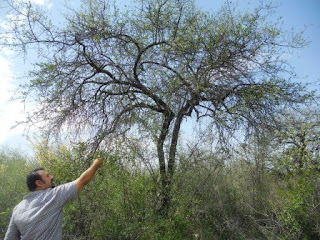
The weather was perfect. Clear blue skies and no trace of the usual heat that bakes our city crispy crisp. What a great way to usher in my first experience doing environmental planning field work in Mexico. For roughly eight hours I walked a 200 acre parcel with a small team from Assesoria Urbanistica y Ambiental. The parcel, located in the rural outskirts of Villa Juarez, sits on the edge of the rapidly expanding exurbs of Monterrey, Nuevo Leon.

The landscape was a collection on rolling hills which were covered by the typical Tamaulipan mezquital which is characteristic of this region. The biome was similar to the lands that I had surveyed in South Texas, though much drier due to a combination of higher heat, lower humidity, and lower rainfall. Despite the drier characteristics of this part of the region, the area had a high level of biodiversity than I had expected. There were obviously dominant communities of plant species commonly seen throughout the site. The real surprises where in apparent mutations of the dominant plant species in the area.

Mutations were varied but the most common were plants growing much larger than their expected normal size as well plant varieties that should have had spines but did not. This was the case with a beautiful blue agave in which we found under the protected canopy of a blooming huisache tree. The agave should have had the same characteristics as all of the surrounding agaves on the parcel but it was smooth and without any hint of the jagged teeth so commonly found with this local species.

There was also evidence of animal life all throughout the property. Most notable were the sun bleached bones and the piles of javelina hairs (wild pigs) evident in various locations around the property. In addition to the javelina, there were many varieties of birds, insects, and tarantulas…….which are all for the most part harmless. Not everything that roams the countryside is harmless however.
A very real danger in this region is rattlesnakes and while I did not see any of these dangerous and territorial reptiles, I did encounter several instances of hearing the rattle while I was walking though the scrubby underbrush. The signature rattle sends a message that says, “back off or suffer a serious consequence!”…..which is the least desirable sound that one wants to hear when walking in the middle of nowhere………Through years of experience living in and roaming around the Mojave Desert, that signature rattle is something that always keeps me on edge and aware of my surroundings.
Everywhere throughout this property, the evidence of old road cuts could be seen. These roads had been unused for many years and thus were covered by thick piles of dry and spiny plants and grasses….no doubt a large portion of this growth coming from the heavy rains of 2010 brought about by the destructive arrival of Hurricane Alex.

All along these long abandoned roads were piles of illegal trash dumping, some of which were burned and others which remained intact. The most common debris was that of tires, beer bottles and plastic but construction materials and electronic equipment were also visibly present wherever we walked. Contamination of the site was obviously something that will have to be looked at closely by the builders.

The state of Nuevo Leon demands that all development companies must provide environmental surveys and reports for all new projects built upon previously undeveloped land. In order to meet this mandate, companies hire private organizations like the one I was contracted to work for so that they can collect data and produce reports that satisfy the requirements of all local laws. Once the report is produced and all regulations have been met, the builders will begin to prepare the site for the eventual construction of over 6,000 new residences. In retrospect I would have to say it was an incredible learning experience.

No comments:
Post a Comment